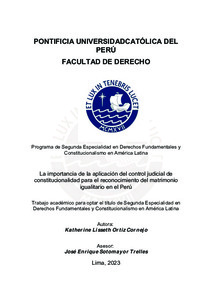| dc.contributor.advisor | Sotomayor Trelles, José Enrique | |
| dc.contributor.author | Ortiz Cornejo, Katherine Lisseth | |
| dc.date.accessioned | 2024-03-07T13:56:27Z | |
| dc.date.available | 2024-03-07T13:56:27Z | |
| dc.date.created | 2023 | |
| dc.date.issued | 2024-03-07 | |
| dc.identifier.uri | http://hdl.handle.net/20.500.12404/27263 | |
| dc.description.abstract | Como bien es sabido, la población LGBTIQ+ ha sido histórica y estructuralmente
discriminada en nuestro país. Por tal motivo, la presente investigación surgió
como respuesta a las recientes sentencias emitidas por el Tribunal
Constitucional sobre el reconocimiento del matrimonio igualitario en el Perú
(casos Óscar Ugarteche, Andree Martinot y Susel Paredes) y la falta de
deliberación parlamentaria sobre dicha materia. Razón por la cual, se tiene como
objetivo respaldar la teoría de que el Tribunal Constitucional se encuentra
facultado para realizar un control fuerte de constitucionalidad —mas aún si se
encuentra frente a una población en especial situación de vulnerabilidad—, el
cual permita el reconocimiento del matrimonio igualitario en el Perú.
De ahí que, a través del presente trabajo académico, se propone realizar un
análisis de las diferentes estrategias jurídicas empleadas por las Cortes
Constitucionales del derecho comparado (Estados Unidos, Colombia y Ecuador),
respecto del reconocimiento del matrimonio igualitario. Así como, un estudio que
contraste las sentencias emitidas por el Poder Judicial —en primera instancia—
y el Tribunal Constitucional, correspondiente a la referida materia. Finalmente,
se expondrán cada uno de los argumentos por los cuales, la autora considera
que no resulta aplicabla la tesis waldroniana —contraria al control judicial o
judicial review— en el caso peruano. | es_ES |
| dc.description.abstract | As is well known, the LGBTIQ+ population has been historically and structurally
discriminated against in our country. For this reason, this investigation arose in
response to the recent rulings issued by the Constitutional Court on the
recognition of equal marriage in Peru (Óscar Ugarteche, Andree Martinot and
Susel Paredes cases) and the lack of parliamentary deliberation on said matter.
For this reason, the objective is to support the theory that the Constitutional Court
is empowered to carry out a strong control of constitutionality —even more so if
it is faced with a population in a particularly vulnerable situation— which allows
the recognition of the equal marriage in Peru.
Hence, through this academic work, it is proposed to carry out an analysis of the
different legal strategies used by the Constitutional Courts of comparative law
(United States, Colombia and Ecuador), regarding the recognition of equal
marriage. As well as, a study that contrasts the sentences issued by the Judiciary
—in the first instance— and the Constitutional Court, corresponding to the
aforementioned matter. Finally, each of the arguments will be presented for which
the author considers that the Waldronian thesis —contrary to judicial review— is
not applicable in the Peruvian case. | es_ES |
| dc.description.uri | Trabajo académico | |
| dc.language.iso | spa | es_ES |
| dc.publisher | Pontificia Universidad Católica del Perú | |
| dc.rights | info:eu-repo/semantics/openAccess | es_ES |
| dc.rights | Atribución 2.5 Perú | * |
| dc.rights.uri | http://creativecommons.org/licenses/by/2.5/pe/ | * |
| dc.subject | Matrimonio del mismo sexo--Perú | es_ES |
| dc.subject | Tribunales constitucionales--Jurisprudencia--Perú | es_ES |
| dc.subject | Control constitucional--Perú | es_ES |
| dc.subject | Derecho comparado | es_ES |
| dc.title | La importancia de la aplicación del control judicial de constitucionalidad para el reconocimiento del matrimonio igualitario en el Perú | es_ES |
| dc.type | info:eu-repo/semantics/bachelorThesis | es_ES |
| thesis.degree.name | Segunda Especialidad en Derechos Fundamentales y Constitucionalismo en América Latina | es_ES |
| thesis.degree.level | Título Profesional | es_ES |
| thesis.degree.grantor | Pontificia Universidad Católica del Perú. Facultad de Derecho | es_ES |
| thesis.degree.discipline | Derechos Fundamentales y Constitucionalismo en América Latina | es_ES |
| renati.advisor.dni | 45486817 | |
| renati.advisor.orcid | https://orcid.org/0000-0002-1155-0249 | es_ES |
| renati.author.dni | 70818407 | |
| renati.discipline | 421189 | es_ES |
| renati.level | https://purl.org/pe-repo/renati/level#tituloSegundaEspecialidad | es_ES |
| renati.type | https://purl.org/pe-repo/renati/type#trabajoAcademico | es_ES |
| dc.publisher.country | PE | es_ES |
| dc.subject.ocde | https://purl.org/pe-repo/ocde/ford#5.05.01 | es_ES |







